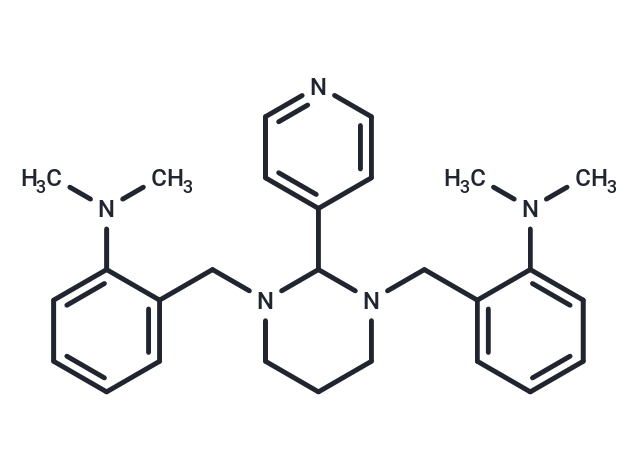Shopping Cart
- Remove All
 Your shopping cart is currently empty
Your shopping cart is currently empty
GANT 61 (GANT61) is an inhibitor for Gli1 and Gli2.

| Pack Size | Price | Availability | Quantity |
|---|---|---|---|
| 2 mg | $33 | In Stock | |
| 5 mg | $52 | In Stock | |
| 10 mg | $81 | In Stock | |
| 25 mg | $169 | In Stock | |
| 50 mg | $323 | In Stock | |
| 100 mg | $453 | In Stock | |
| 500 mg | $1,050 | In Stock |
| Description | GANT 61 (GANT61) is an inhibitor for Gli1 and Gli2. |
| Targets&IC50 | GLI1:5 μM |
| In vitro | Nude mice bearing SK-N-AS neuroblastoma xenografts administered orally with 50 mg/kg GANT61 exhibited significant tumor growth inhibition on day 12 of the experiment, achieving a 63% reduction in tumor volume compared to the control group. Additionally, in nude mice injected with GLI1-positive 22Rv1 prostate cancer cells, GANT61 induced tumor regression to the point where no discernible tumors were observed. |
| In vivo | GANT61 effectively inhibits tumor cell proliferation in vitro through a GLI-dependent mechanism. At a concentration of 30μM, GANT61 halts growth and induces apoptosis in acute myeloid leukemia cells. It exhibits potent cytotoxicity towards human colon cancer cell lines, eradicating colony formation. GANT61 specifically targets chronic lymphocytic leukemia cells over normal B lymphocytes, triggering apoptosis. In the early S phase of human colon cancer cell lines, GANT61 induces DNA replication inhibition leading to DNA damage signaling through the ATM-Chk2 axis and consequent cell death. Furthermore, GANT61 inhibits GLI1's DNA binding capability and suppresses the hedgehog signaling pathway with an IC50 of 5μM, displaying higher selectivity over other pathways (such as TNF signaling/NFκB activation, glucocorticoid receptor gene transcription, and the Ras-Raf-Mek-Mapk cascade). |
| Kinase Assay | Dual Luciferase Assay: HEK293 cells are transfected with GLI1 expression plasmid, together with the reporter plasmids 12×GliBSLuc and R-Luc on 10-cm plates (day 0). Twenty-four hours later, cells are seeded in white 96-well plates with clear bottom at a density of 15,000 cells per well. Cells are allowed to attach, and compounds are added at a final concentration of 10 μM in DMSO (0.5% final DMSO concentration) (day 1.5). Cells are grown for another 24 h, subsequently lysed, and then analyzed by using the Dual Luciferase kit. |
| Cell Research | BrdU Incorporation Assay. Subconfluent cells are grown in reduced FBS (2.5%) for 48 h in the presence of 5 μM test compound (or DMSO) on white 96-well plates with clear bottom. Subsequently, cells are labeled for 2 h with BrdU, fixed, and analyzed.(Only for Reference) |
| Synonyms | NSC 136476, GANT61 |
| Molecular Weight | 429.6 |
| Formula | C27H35N5 |
| Cas No. | 500579-04-4 |
| Smiles | CN(C)c1ccccc1CN1CCCN(Cc2ccccc2N(C)C)C1c1ccncc1 |
| Relative Density. | 1.134 g/cm3 (Predicted) |
| Storage | Powder: -20°C for 3 years | In solvent: -80°C for 1 year | Shipping with blue ice/Shipping at ambient temperature. | ||||||||||||||||||||||||||||||||||||||||
| Solubility Information | DMSO: 4.3 mg/mL (10 mM), Sonication is recommended. Ethanol: 43 mg/mL (100.09 mM), Sonication is recommended. | ||||||||||||||||||||||||||||||||||||||||
| In Vivo Formulation | 10% DMSO+40% PEG300+5% Tween 80+45% Saline: 1 mg/mL (2.33 mM), Sonication is recommended. Please add the solvents sequentially, clarifying the solution as much as possible before adding the next one. Dissolve by heating and/or sonication if necessary. Working solution is recommended to be prepared and used immediately. The formulation provided above is for reference purposes only. In vivo formulations may vary and should be modified based on specific experimental conditions. | ||||||||||||||||||||||||||||||||||||||||
Solution Preparation Table | |||||||||||||||||||||||||||||||||||||||||
DMSO/Ethanol
Ethanol
| |||||||||||||||||||||||||||||||||||||||||

Copyright © 2015-2025 TargetMol Chemicals Inc. All Rights Reserved.